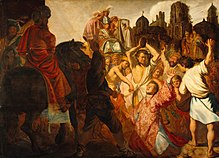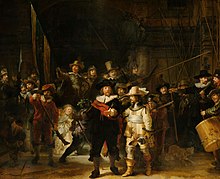Rembrandt. All paintings
Rembrandt. Complete Paintings is a by art historians Volker Manuth de, Marieke angle and Rudie van Leeuwen authored and published by Pocket published works of paintings by Dutch painter and printmaker Rembrandt van Rijn . The book was published on the 350th anniversary of Rembrandt's death in 2019, simultaneously in German, English, Dutch and French. In a second volume by the publisher, Rembrandt. All drawings and etchings by Peter Schatborn and Erik Hinterding , Rembrandt's drawings and etchings are presented in the same format. A smaller volume, Rembrandt , published in the same year and written by Manuth and de Winkel . The self-portraits represent once again this excerpt from his complete works.
background
The last catalog raisonné of Rembrandt's paintings with scientific aspirations was the Corpus of Rembrandt Paintings published in six volumes by the Dutch Rembrandt Research Project from 1982 to 2015 . It had the objective, the picturesque body of work complete and of erroneous Rembrandt attributions freed play. The sixth and last volume of the Corpus , published by Springer Science + Business Media , is mainly illustrated in color. However, it places much more value on the text and on solving the attribution problem and, with its price of more than 1000 euros for the e-book and almost 1300 or 1400 euros for the bound editions, is geared towards professional readers. The last German-language catalog raisonné was submitted in 1986 by Christian Tümpel .
description

Rembrandt. All paintings contain descriptions and large-format images of 330 paintings by Rembrandt. The volume of the underlying complete works largely corresponds to the sixth volume of the corpus , which contains 324 catalog numbers. The volume comprises 744 pages in the format of 29 × 39.5 cm and weighs more than eight kilograms. The dust jacket shows a detail of Rembrandt's self-portrait as the Apostle Paul .
Biography and picture part
The short foreword by the authors is followed by a Rembrandt biography in four chapters, each introducing the relevant part of the picture:
- I. Rembrandt's Beginnings in Leiden 1606–1631, p. 14
- II. Amsterdam 1631-1639, p. 80
- III. Illusionism and Reorientation 1640–1651, p. 268
- IV. Rembrandt's late work 1652–1659, p. 362
In terms of content, the biography reflects the current status of Rembrandt research. The texts are provided with numerous notes, which often refer to the catalog raisonné of the drawings and etchings. If work titles are mentioned here, then the catalog number is also mentioned. It also contains a total of 296 footnotes, which are not printed in a reader-friendly way at the end of the book and which are mostly short references to literature references. These are in turn itemized in the 25-page bibliography. Often documents about Rembrandt's life are given, all of them in citations like "RD 1617/1". The unexplained numbering follows The Rembrandt Documents by Walter L. Strauss and Marjon van der Meulen from 1979.
Each of the four biography sections is followed by a picture with the works of the period. The pictorial equipment includes a large-format image for each painting discussed, to which a few lines with title, year, material and format and owner are added. The catalog numbers are missing here, so that readers can only find a work in the catalog via the work register or by leafing through it. The brief information helps the reader nonetheless, because they mark the "actual" image of a painting. In addition, the biographical texts as well as the picture parts are equipped with detailed recordings of Rembrandt's paintings, pictures of his drawings and etchings and pictures of works by other artists.
For a work conceived and advertised as an illustrated book, a serious deficiency emerges in many of the illustrations. Rembrandt painted mostly portrait formats, but pieces such as The Stoning of St. Stephen and many of his history pictures and group portraits are landscape formats. The stoning is shown in the correct position on one side, with generous open spaces above and below. Half of the space available for imaging is thus lost. The Leiden history painting shows an alternative approach. The illustration goes in the correct position over a double page, with more than a third on the left of the gutter and the rest on the right. The gutter is between the king and his scribe. He consumes a large part of Rembrandt's small self-portrait, an important part of the picture. During the night watch , almost only the buttocks and the right leg of the musketeer striding to the right remain, the captain's right hand is isolated on the left side. The small self-portrait of Rembrandt disappears in the gutter. Immediately afterwards, two fold-out double pages offer a detail section with Rembrandt's head and the captain's entire arm, the gutter going through his head. The affected paintings appear compressed in width, and the loss of a vertical stripe in the center of the picture destroys the composition.
Rembrandt's painting was perceived by contemporaries as somber. The aging of the layers of paint and the varnish often makes image details and color impressions disappear. This has also been made clear in the past in works such as the Corpus , the illustration of which has been criticized as too dark. The present illustrated book shows more Rembrandt than ever before. For this purpose, the paintings are brightened in such a way that questions such as the number of people or pikes on the night watch can easily be answered. Some of Rembrandt's early works in particular are given a color scheme that raises the question of authenticity.
Catalog part
The catalog of works begins well in the second half of the volume. In contrast to the sixth volume of the Corpus , which seeks to list Rembrandt's complete works in chronological order, Manuth and colleagues first organize their work according to groups of motifs, and within the groups according to the year of origin:
- Old testament
- New Testament
- Religious individual figures
- mythology
- Ancient history and individual figures
- Allegories
- Unexplained history
- Genre representations
- Animal pieces and still lifes
- Landscapes
- Self-portraits
- Male individual portraits
- Female individual portraits
- Counterpart portraits
- Group portraits
- Single male figures and tronies
- Single female figures and tronies
The classification depends on a by no means reliable interpretation of the pictures. All of the paintings listed in the catalog are reproduced in small format, with one or two full-page images of details at the transition from one group of motifs to the next. The catalog texts initially state the title and year of creation of the work, material and dimensions in a few lines, followed by information on the signature and the collection including the inventory number. The rest of the catalog text is about half a page for each painting, and even in the case of complex and extensively researched masterpieces such as Captain Frans Banninck Cocq's company . The current state of research on the painting is briefly outlined in the running text, but no information about the provenance is given. This is followed by a concordance of the catalogs of works, starting with the descriptive and critical catalog by Cornelis Hofstede de Groot from 1915 to the corpus , and the most important literature on the work.
A further and completely redundant concordance of the work numbers can be found on three pages at the end of the volume ; there is no concordance sorted by the work numbers of the corpus , which would make it easier to find the work numbers in the present volume. Many works are difficult to find in the register because only the titles specified by the authors are listed. For readers who are not familiar with Rembrandt's work and the various or many names of his works, the classification of the night watch under K as (the) company of Captain Frans Banninck Cocq ("The Night Watch") or the Jewish bride under P as a portrait of a couple as Isaac and Rebekah ("The Jew's Bride") a difficulty.
reception
During that time, Alexander Cammann discussed both catalogs of works by Taschen Verlag together: “Two monumental volumes present all drawings and etchings as well as all paintings as work catalogs in excellent reproduction quality; their weight tests the resilience of shelf and coffee table ”.
Kia Vahland pointed out in the Süddeutsche Zeitung that the almost haptic and therefore emotional aspect of the application of paint in Rembrandt's late work can only be fully experienced before the original. She judges: "Taschen-Verlag has dared to publish a large volume of works - and an overview of Rembrandt's art has succeeded, which leads across his life's work in astonishingly good print quality." Even pasty late works such as Isaak and Rebekka made their way through the amazingly good print quality. Vahland described the catalog entries and the body text of the volume as a “factual introduction to Rembrandt's painting”. Following the claim of a catalog raisonné, one would “sometimes wish for more explanations on the state of research and the various interpretations”.
The reviewer of the Aachener Zeitung highlighted the equipment: “The real treasure of the volume, however, are the large-format images of the paintings. The large format of the volume allows one to discover many details that document Rembrandt's mastery in the most excellent way ”.
The English-language edition was reviewed by Jackie Wullschläger in the Financial Times as one of the best art books of 2019. Taschen's oversized format goes perfectly with Rembrandt, who based his compositions on the finest details. Texture, color and light would resonate in the illustrations.
The British painter and graphic artist David Hockney praised Taschen Verlag, including the volume with the drawings and etchings and the less extensive work on self-portraits: "With these books you brought Rembrandt into the 21st century" (English: "With these books, you have brought Rembrandt into the 21st century ”).
expenditure
- Volker Manuth, Marieke de Winkel, Rudie van Leeuwen: Rembrandt. All paintings . Taschen Verlag, Cologne 2019, ISBN 978-3-8365-2631-9 (744 pages, hardcover with fold-out pages, 29 × 39.5 cm, 8.07 kg).
- Rembrandt. The Complete Paintings . Taschen, Cologne 2019, ISBN 978-3-8365-2632-6 (English, 743 pages).
- Rembrandt. All Schilderijen . Taschen, Keulen 2019, ISBN 978-3-8365-7235-4 (Dutch, 743 pages).
- Rembrandt. Tout l'oeuvre torments. Traduit de l'allemand par Caroline Jouannic, Wolf Fruhtrunk . Taschen, Cologne, Paris 2019, ISBN 978-3-8365-2633-3 (French, 743 pages).
Individual evidence
- ^ The Rembrandt Research Project is complete . Springer Science + Business Media website , October 13, 2014, accessed March 20, 2020.
- ^ Christian Tümpel : Rembrandt. Myth and Method. With contributions by Astrid Tümpel . Mercatorfonds, Antwerp 1986, ISBN 90-6153-165-9 .
- ↑ a b Magic of Light. Rembrandt. All paintings in XXL resolution. Taschen Verlag, accessed on March 20, 2020 .
- ↑ Alexander Cammann : Heavily brilliant . In: The time . October 1, 2019 ( zeit.de [accessed March 20, 2020]).
- ↑ Kia Vahland : Hand on heart. Illustrated books: Rembrandt . In: Süddeutsche Zeitung . December 23, 2019 ( sueddeutsche.de [accessed March 20, 2020]).
- ↑ The heyday of Dutch art during the Baroque. All of Rembrandt's paintings . In: Aachener Zeitung . September 9, 2019 ( aachener-zeitung.de [accessed March 20, 2020]).
- ↑ Jackie Wullschläger : Best books of 2019: Art . In: Financial Times . November 22, 2019 (English, ft.com [accessed March 20, 2020]).



